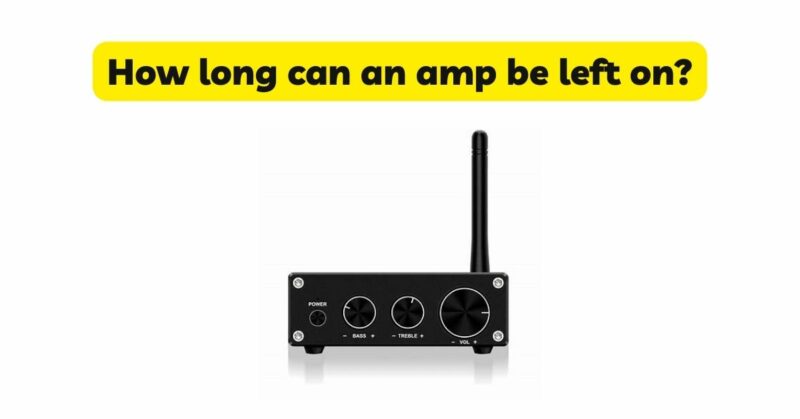The duration for which an amplifier can be left on is a common concern among audio enthusiasts. While some individuals prefer to leave their amplifiers on continuously for convenience, others worry about the potential consequences of extended operation. In this article, we will explore the factors that determine how long an amplifier can be left on, including its design, component tolerances, and practical considerations. By understanding the operational limits and following best practices, audio enthusiasts can make informed decisions regarding the duration of amplifier operation.
I. Determining the Operational Limits:
- Design and Build Quality: The design and build quality of an amplifier play a crucial role in determining its operational limits. Well-engineered amplifiers with robust components are typically designed to withstand extended operation without adverse effects.
- Heat Dissipation: Heat is a byproduct of amplifier operation, and excessive heat can lead to component damage. The amplifier’s heat dissipation capabilities, including heat sinks, fans, and ventilation, determine its ability to handle prolonged operation.
- Component Tolerances: The tolerances of various components within the amplifier, such as capacitors, transistors, and integrated circuits, influence the duration of safe operation. Components with higher quality and wider operational tolerances tend to handle extended use more effectively.
II. Factors Affecting Operational Durability:
- Amplifier Class: Different amplifier classes, such as Class A, Class AB, Class D, and Class H, have varying operational characteristics and heat generation profiles. Each class has its own recommended operating duration, and adhering to these guidelines ensures optimal performance and longevity.
- Load and Volume: The load placed on the amplifier, determined by the connected speakers and the volume at which the system is played, can influence the operational duration. Higher volumes and demanding speaker loads generate more heat, potentially shortening the safe operational period.
- Ambient Temperature: The ambient temperature in which the amplifier operates affects its cooling efficiency. Higher ambient temperatures reduce the amplifier’s ability to dissipate heat, potentially necessitating shorter operational durations to prevent excessive heat buildup.
III. Practical Considerations:
- Manufacturer Recommendations: It is important to consult the amplifier’s user manual or manufacturer’s guidelines for specific recommendations regarding operational durations. Manufacturers often provide insights into the optimal usage patterns, including suggested break-in periods, recommended rest intervals, and guidelines for extended usage.
- Heat Management: Proper heat management is essential for the safe operation of an amplifier. Ensure that the amplifier is placed in a well-ventilated area, away from heat sources and obstacles that may impede proper airflow. This allows the amplifier to dissipate heat effectively, promoting longer operational durations.
- Break-In Period: Some amplifiers benefit from a break-in period during which they stabilize and reach optimal performance. The manufacturer may recommend specific operational guidelines for the initial hours or days of use, including suggestions for the duration of continuous operation during this break-in period.
IV. Practical Usage Scenarios:
- Intermittent Use: If the amplifier is primarily used for shorter listening sessions or occasional use, it is advisable to power off the amplifier when not in use. This conserves energy and reduces wear on components, potentially extending the overall lifespan of the amplifier.
- Extended Listening Sessions: In scenarios where extended listening sessions are common, such as in home theaters or professional audio setups, amplifiers are designed to handle prolonged operation. Following manufacturer guidelines and ensuring proper heat management allows for safe and reliable operation during these extended periods.
V. Monitoring and Maintenance:
- Monitoring Temperature: It is important to monitor the amplifier’s temperature during operation. Some amplifiers are equipped with temperature sensors or built-in protection mechanisms that automatically shut down the amplifier if the temperature exceeds safe limits.
- Regular Maintenance: Regular maintenance, including cleaning dust accumulation and checking for any signs of component degradation, helps ensure optimal performance and longevity. This may involve periodic inspections by qualified technicians to address any potential issues.
VI. Conclusion:
The duration for which an amplifier can be safely left on depends on various factors, including its design, heat dissipation capabilities, component tolerances, and usage patterns. Well-designed amplifiers with efficient heat management systems can handle extended operation without adverse effects. Adhering to manufacturer guidelines, monitoring temperature, and practicing regular maintenance are crucial for maintaining the amplifier’s performance and longevity. By understanding these factors and considering practical usage scenarios, audio enthusiasts can make informed decisions about the operational duration of their amplifiers, striking a balance between convenience and the health of the equipment.


